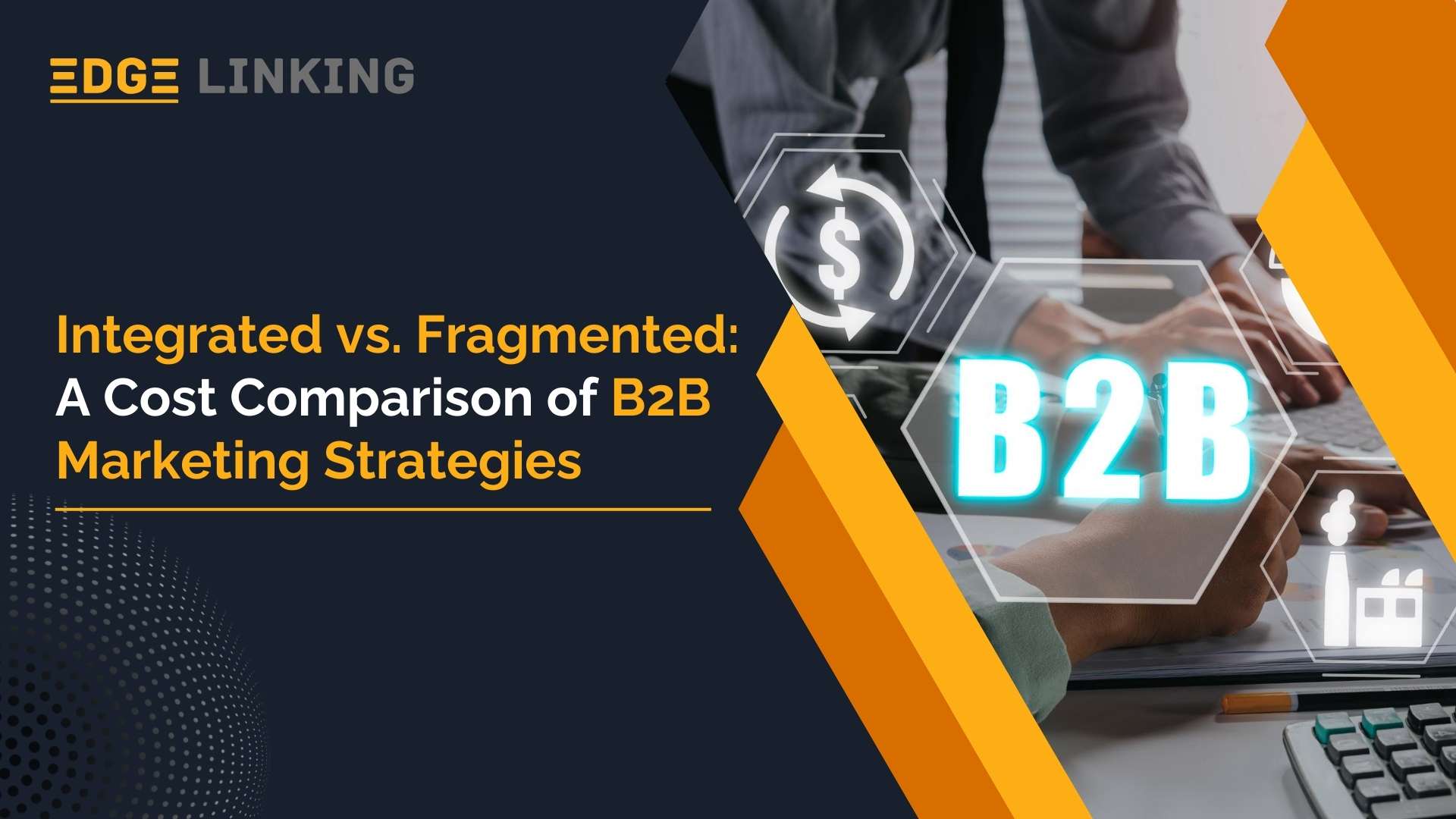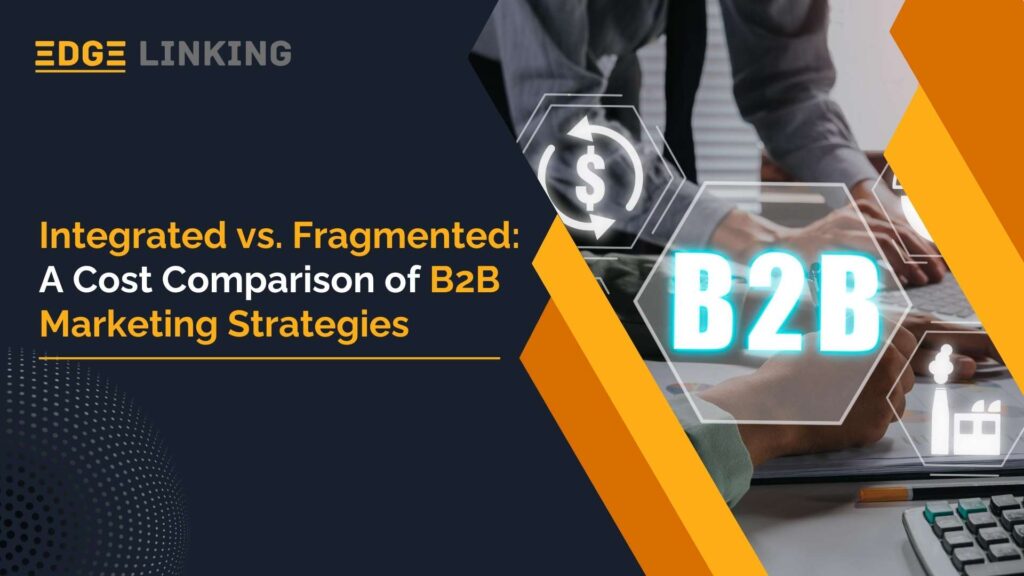With the evolving B2B landscape, every marketing dollar is under scrutiny. Every dollar spent needs to justify its return, and the allocated budget can make or break campaigns.
Conducting a cost comparison of marketing strategies is necessary to maximize ROI. Many organizations absorb “leakage costs” such as duplicated creative production, uncoordinated media buys, and inconsistent brand positioning that weakens trust. A thorough comparison helps to understand how the reallocation of budget toward an approach can improve both marketing efficiency and business impact.
This article will explain the need for cost comparison for fragmented and integrated marketing strategies.
Integrated Marketing vs. Fragmented Marketing
The following are the key differences between integrated and fragmented marketing strategies.
1.Strategic Alignment
Integrated Marketing Strategy: All campaigns, channels, and messages are aligned to a unified business objective.
Example: A SaaS company launching a new analytics tool aligns its LinkedIn ads, email campaigns, and content marketing under the same value proposition: “Empowering real-time decision-making.”
Fragmented Marketing: Teams operate in silos, creating disconnected campaigns that may compete for resources.
Example: The same SaaS company’s events team promotes the tool as “Data Simplified,” while digital ads push “Advanced AI Insights” without connecting the two.
2.Resource Utilization & Cost Efficiency
Integrated Marketing: Shared creative assets, consolidated vendor relationships, and unified tech stacks.
Example: One set of campaign visuals and messaging is adapted for email, webinars, and sales decks, lowering production costs.
Fragmented Marketing: Different departments commission separate creatives, tools, and campaigns, increasing spending.
Example: Each regional marketing team hires its design agency for similar campaigns, multiplying costs.
3.Data and Insights
Integrated Marketing: Centralized analytics provide a holistic view of performance across channels, impacting budget allocation.
Example: Marketing leaders see that LinkedIn ads drive awareness, webinars drive conversions, and email nurtures leads.
Fragmented Marketing: Data is trapped in silos, making it hard to track customer journeys or measure ROI.
The paid media team lacks visibility into how their leads perform in email nurture flows, resulting in misaligned KPIs.
4.Customer Experience
Integrated Marketing: Delivers a seamless journey from first touch to closed deal, strengthening trust and brand equity.
Example: A prospect who downloads an eBook receives follow-up emails, sees aligned social ads, and gets invited to a product demo.
Fragmented Marketing: Creates a disjointed experience with inconsistent offers or CTAs, reducing engagement.
Example: The same prospect sees conflicting offers from different teams, leading to a drop-off.
How to Do a Cost Comparison of Fragmented and Integrated Marketing Strategies
Below is a step-by-step approach.
1.Map All Marketing Activities and Channels
What to Do: Document every marketing initiative, channel, and vendor across the organization, such as digital, events, ABM, content creation, and PR.
Example: A manufacturing solutions provider includes trade shows, ABM campaigns, paid search, and content creation in the analysis.
2.Identify All Associated Costs
What to Do: Capture both direct costs (media spend, creative production, event fees) and indirect costs (agency retainers, technology licenses, team bandwidth).
Example: In a fragmented model, your regional marketing teams may each pay for separate email platforms, while an integrated model uses one centralized tool.
3.Identify Overlap and Duplication
What to Do: Identify and consolidate duplicated vendor contracts, Tech tools, and creative efforts.
Example: A cloud services company in a fragmented setup may hire three different video agencies for product explainer videos. An integrated approach uses one master video, adapted for multiple markets, saving production costs.
4.Evaluate Campaign Efficiency
What to Do: Measure cost per lead (CPL), cost per opportunity (CPO), and cost per acquisition (CPA) for campaigns.
Example: An integrated marketing strategy allows global templates for sales decks, cutting down design hours. Fragmented teams may recreate decks from scratch for each market.
5.Measure the Lifetime Value (LTV) Impact
What to Do: Compare the customer lifetime value generated under each approach. Integrated marketing drives higher LTV due to improved customer experiences.
Example: Consistent messaging in onboarding, product updates, and upsell campaigns increases LTV, but inconsistent interactions post-sale led to missed upsell opportunities.
6.Analyze the Time-to-Market
What to Do: Track how quickly campaigns can be launched with each approach. Speed impacts both opportunity and cost.
Example: Shared resources and centralized planning allow a manufacturing solutions company to launch a global campaign in two weeks. Disconnected approvals delay campaign launches, increasing competitive risk.
7.Assess Brand Consistency Costs
What to Do: Consider the cost of brand dilution, as fragmented campaigns can require additional investment for inconsistent brand perception.
Example: Every touchpoint reinforces the same brand promise, reducing the need for corrective PR or rebranding efforts, while conflicting messaging creates market confusion.
8.Project Future Cost Savings from Integration
What to Do: Use the data to forecast cost reductions if an integrated marketing strategy replaced fragmented strategies.
Example: A global IT solutions provider projects annual savings by consolidating agencies, tech tools, and creative resources.
The Significance of Cost Comparison of Marketing Strategies
Here’s why you need to make a cost comparison of the strategies.
1.Uncovers ROI
Why It Matters: Without a structured cost comparison, leadership may assume higher spending equals better results.
Example: A cybersecurity solutions firm finds that its integrated marketing strategy delivers higher-quality leads at a lower cost per acquisition.
2.Supports Strategic Budget Allocation
Why It Matters: A cost comparison shows where the budget should be reallocated for impact, rather than applying blind cuts.
Example: An integrated approach reveals that trade shows generate awareness but low conversions, while targeted ABM drives higher revenue. The company reallocates the spending to ABM.
3.Strengthens Cross-Channel Synergy
Why It Matters: When you compare costs, you see how coordinated campaigns create results.
Example: A cloud services company’s integrated marketing combines content marketing, SEO, and targeted ads, lowering customer acquisition costs.
4.Improves Decision-Making
Why It Matters: CFOs and CMOs can align when decisions are backed by cost and performance data.
Example: Presenting a comparison of integrated vs. fragmented spend helps leadership approve investment.
5.Builds a Business Case for Integration
Why It Matters: Many organizations resist shifting from fragmented to integrated due to complexity. Cost comparisons make the benefits tangible.
A logistics provider demonstrates to stakeholders how integration will reduce vendor contracts and improve lead-to-close time.
Conclusion
For C-suite leaders, the integration decision is more about how quickly the organization can transition to it. A cost comparison is the lens into the health of your marketing function. It gives you the clarity to allocate resources where they will create the greatest return. If you’re ready to uncover the hidden costs and design an integrated approach that drives ROI, it’s time to act.






